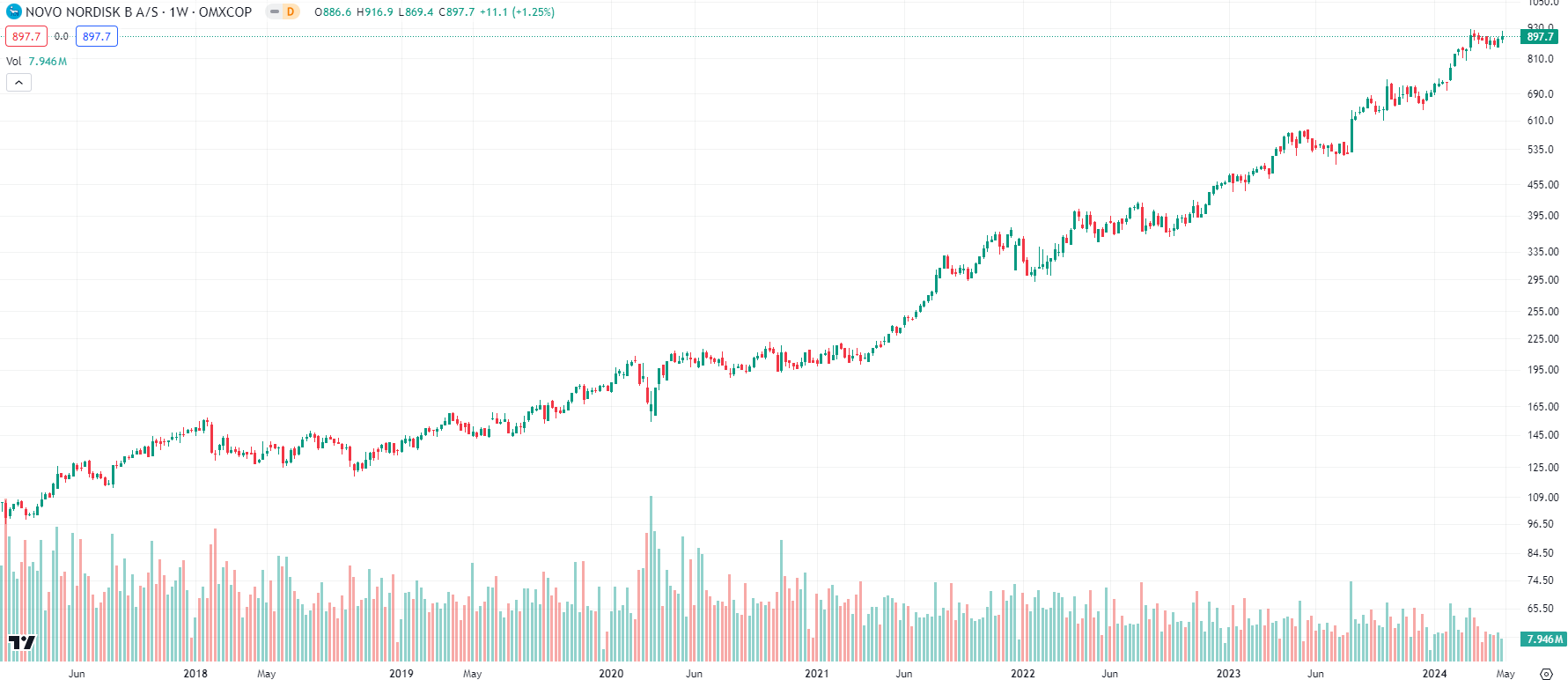Novo Nordisk (CPH: NOVO-B): It’s not all smooth sailing for the US$400bn company behind obesity drug Ozempic
![]() Nick Sundich, May 6, 2024
Nick Sundich, May 6, 2024
Not many 100-year old healthcare stocks see a sudden 30% jump in sales in one year, but Novo Nordisk (CPH: NOVO-B) is one such stock that did in 2023. Its a Danish drug maker that is behind weight loss drugs Ozempic and Wegovy. For much of its history, it had a focus on treating diabetes and still produces half the world’s insulin. But obesity is a much bigger market – over 40% of adults in the USA, and now it is targeting this market.
There is an enormous opportunity ahead of the company, yet there are also a lot of risks that need to be overcome. So, while this could be one of the biggest global winners this decade, and perhaps the first ever US$1tn health company, it is no guarantee that it will happen.
History of Novo Nordisk
Novo Nordisk’s history is intertwined with that of insulin. August Krogh, a Danish physiologist married to a doctor living with diabetes, secured the rights to produce the drug in Denmark in 1922 and founded the company a year later, then Nordisk Insulinlaboratorium. It was only another two years later (in 1925) that rival Novo Terpeutisk Laboratorium was founded by a chemist that had been fired from Nordisk and was consequently disgruntled. The companies competed for 6 decades before merging in 1989 and becoming the world’s largest producer of insulin. By that time, it was far easier to administer insulin, with an ‘insulin pen injection’ introduced in 1985.
At the same time, the company (and its predecessors) were working on treatments for other diseases, but none could be as prominent as insulin. Everything changed in 2017 when the FDA approved Ozempic for the treatment of Type 2 diabetes. And good timing, because that year had been very turbulant with signs the market for insulin was under strain – the company issued three separate profit warnings in one year. The company is up over 400% since Ozempic was FDA approved. Wegovy was approved 4 years later, technically a separate drug, but it uses the same active ingredient.

Novo Nordisk share price chart, log scale (Source: TradingView)
What is Ozempic?
Ozempic is an injection that regulates blood sugar levels and weight loss is a side effect of this. So, while at first it was only diabetics who took it, non-diabetics began embracing it as word of mouth spread about how good it was. Sure, it had no regulatory approval for non-diabetics, but just as we saw with Uber, when a business’ product or service has that compelling an impact, people will go to the point of defying the law in favour of it. And regulators can only keep flipping the bird for so long before they realise their efforts are all in vain.
#Santa's gone slim thanks to #Ozempic in @SteveBreen100's witty exclusive #cartoon featured in today's edition of the #Smerconish.com daily #newsletter! Subscribe for more chuckles: https://t.co/7A2ROB1TJS 🎅 pic.twitter.com/KuEerNJ2qH
— Michael Smerconish (@smerconish) December 7, 2023
2023 was a pivotal year because the company became most valuable in Europe, having surpassed LVMH and has even boosted Denmark’s GDP by 1.8% each. Ozempic took off with popularity because many celebrities claimed to use it, led by Elon Musk and Jimmy Kimmel. In the US alone, over 40 million people were prescribed it in 2023.
Big jump in earnings in 2023
In 2023, company made DKK232.3bn (US$33.7bn) in sales, a figure up 31% in Danish kroner and 36% at constant exchange rates. Its profit was DKK102.6bn, up 37% in kroner and 44% at constant exchange rates. The company has told investors to expect 18-26% sales growth this year. Another recent catalyst for the company was expanded approval of Wegovy for cardiovascular injections which will boost the market for that drug.
There is the question of what impact Ozempic will have on other healthcare stocks. Will it wipe out plenty of markets, given that if you reduce obesity, you reduce health issues that can result from it. We’ve addressed this question elsewhere, this article is about Ozempic from Novo Nordisk’s perspective.
So what’s not to love about Novo Nordisk?
There’s very little at first glance. But taking a closer look, there are some issues that the company will need to overcome. With such rapid demand, it will need to invest billions to keep up. Indeed, it spent US$6bn to expand production in 2023, nearly four times the amount spent two years ago. And it will also need to hire thousands of employees. Will it be able to maintain the same company culture and keep them all on the same page?
There is the risk of competition, particularly from Eli Lilly, which sells Mounjaro for diabetes and Zepbound for weight loss. Two thirds of Ozempic’s sales and nearly all of Wegovy’s sales are in the USA. Obviously this could put downward pressure on prices and with it margins.
Price gouging?
US Senator Bernie Sanders pointed out in March 2024 that a Yale study found Ozempic costs less than US$5 a month to manufacture, yet the company charges nearly US$1,000 a month. This can be reduced through insurance plans, Novo Nordisk says most pay under $25, although some refuse to subsidise it due to ballooning costs and questions as to whether or not it is effective. In other countries, there is also the risk of price cuts. The company was forced to cut its price in Denmark from US$188 per month to US$125 per month after public reimbursement negotiations.
There is also the risk of potential side effects that might become more prominent as tens (or even hundreds) of millions of people take it. From a patent perspective, they don’t expire until 2032 and Novo is working on new treatments, including a potential oral tablet.
And finally, there’s the question of what regulators will do. Yes, we said above that consumers will defy regulators if the product is that good. But doctors who prescribe it will be reluctant to ignore regulators. So far in 2024, the Danish Medicines Agency plans to reduce subsidies and only pay for the drugs if patients cannot be treated with better alternatives. And doctors in the UK were instructed to stop prescribing the drug to non-diabetics and prioritise alternatives.
Conclusion
One thing that’s certain about Novo Nordisk is that it is one to keep an eye on, even if you’re not an investor. Although the company has some issues it needs to keep an eye on, the company has seen extraordinary growth that seems set to continue for some time, off the back of a drug that appears to be effective in ways that many predecessor drugs were not, to the point where consumers are ignoring regulators and (in some instances) even their doctors to take it.
What are the Best ASX Stocks to invest in right now?
Check our buy/sell tips
Blog Categories
Get Our Top 5 ASX Stocks for FY25
Recent Posts
The $3m super tax is coming! If you’re invested in equities, here is how it might impact you
It seems during the next 3 years, the $3m super tax will be officially a thing. Itwas blocked by the…
Northern Star Resources (ASX:NST): The $28bn gold miner that stands above them all
Northern Star Resources (ASX:NST) is by far the largest gold company on the ASX, capped at $28bn as of May…
6 ASX stocks you forgot were listed
Here are 6 ASX stocks you forgot were listed Brisbane Broncos (ASX:BBL) No it is not a mistake. This…



